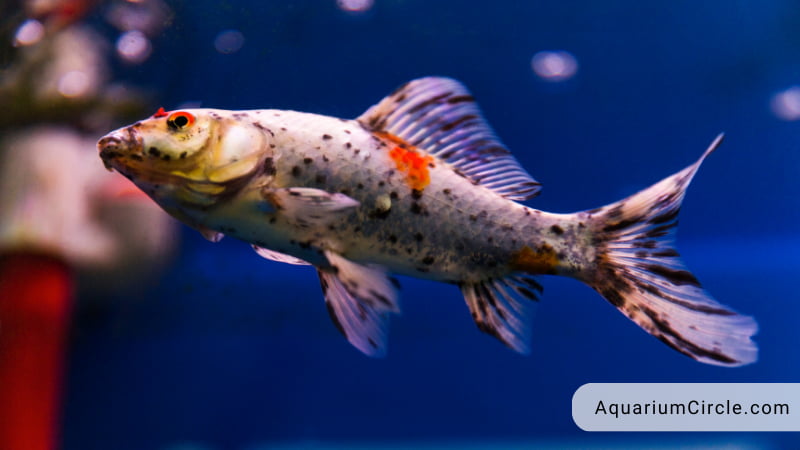Shubunkin Goldfish is a beautiful and popular variety of goldfish that has captivated the hearts of fish enthusiasts around the world. Known for their unique blue and orange speckled pattern, Shubunkin Goldfish are one of the hardiest and most adaptable breeds of goldfish. They are a great choice for beginners looking to keep fish as pets, as they are easy to care for and have a long lifespan.
In this article, we will explore the fascinating world of Shubunkin Goldfish, including their physical appearance, habitat and fish tank requirements, diet and feeding, behavior and temperament, breeding and reproduction, health and disease, and more. Whether you are a seasoned fish keeper or a novice, this guide will provide you with valuable information to help you care for your Shubunkin Goldfish and enjoy their beauty and companionship for years to come.
See also:
- Comet Goldfish Care Guide: Lifespan, Tank Size, Breeding And More
- Fantail Goldfish: Care Guide, Lifespan, Tank Size, Tank Mates In Aquarium And More
- Black Moor Goldfish: Care Guide, Breeding, Lifespan, Tank Size, Tank Mates And More
Shubunkin Goldfish Overview
Shubunkin Goldfish are also known as Calico Goldfish or Speckled Goldfish. They are a stunning addition to both indoor tanks and outdoor ponds. With their vibrant coloration and elegant flowing fins, they are a sight to behold. Their active nature and playful demeanor make them an engaging and fascinating pets, bringing joy and entertainment to their owners.
As a type of goldfish, Shubunkins are the product of selective breeding. The modern-day fish are descendants of the Prussian Carp, a wild carp found in Europe and Asia. While their origin story is not entirely clear, it is believed that Shubunkins were first bred in Japan around the year 1900.
Today, Shubunkin Goldfish are a beloved and popular choice among fish enthusiasts, readily available in pet stores worldwide. Their unique and striking appearance, coupled with their hardiness and adaptability, have made them a staple in aquariums and ponds of all sizes.
Whether you are an experienced fish keeper or a beginner, Shubunkin Goldfish is a rewarding and fascinating addition to any collection. With proper care and attention, these graceful creatures can live long and healthy lives, providing their owners with endless joy and wonder.
Shubunkin Goldfish’s Physical Appearance: Size, Coloration, Variations
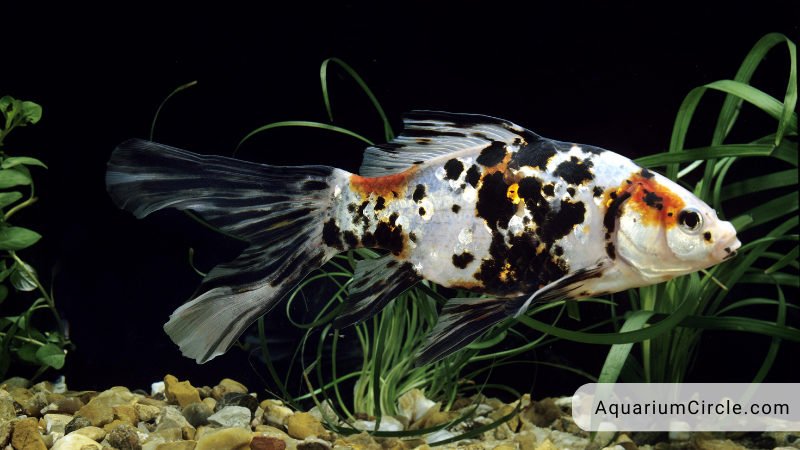
Shubunkin Goldfish are a type of goldfish that are renowned for their unique and eye-catching coloration. Their scales are typically a combination of blue, orange, black, and white, creating a speckled or mottled appearance that resembles a calico cat. This striking coloration gives the fish a distinctive and vibrant appearance, making them a popular choice among fish enthusiasts.
In terms of size, Shubunkin Goldfish can grow up to 8-12 inches in length, making them larger than some other types of goldfish. Their elongated body is streamlined, and their fins are long and flowing, adding to their graceful and elegant appearance.
In addition to their coloration and size, Shubunkin Goldfish also have a unique set of physical features that distinguish them from other breeds. They have a dorsal fin that is located near the middle of their back, rather than at the back of their body like many other fish. They also have a pair of barbels, or sensory organs, located near their mouth that help them detect food and other objects in the water.
Differences between Shubunkin and other types of goldfish
Shubunkin Goldfish are a unique and distinct type of goldfish that have several notable differences when compared to other breeds. Here are a few of the main differences:
- Coloration: The most distinctive feature of Shubunkin Goldfish is their coloration. Unlike other goldfish varieties that are typically solid colored or have a single dominant color, Shubunkins have a mottled or speckled appearance that incorporates a combination of blue, orange, black, and white.
- Size: Shubunkin Goldfish are larger than many other types of goldfish. While some breeds only grow up to 6 inches in length, Shubunkins can reach up to 8-12 inches in length.
- Dorsal fin placement: Shubunkins have a dorsal fin that is located closer to the middle of their back, whereas other goldfish have a dorsal fin that is situated closer to their tail.
- Body shape: Shubunkin Goldfish have a long and slender body shape that is more streamlined than some other goldfish varieties.
- Barbels: Shubunkins have a pair of barbels located near their mouth, which are sensory organs that help them detect food and other objects in the water. While some other types of goldfish also have barbels, they are not as prominent as they are in Shubunkins.
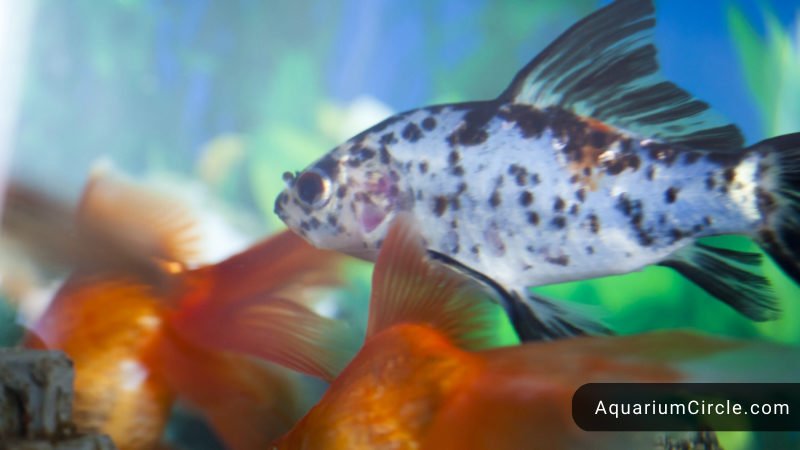
How many types of Shubunkins?
There is only one Shubunkin Goldfish, but within that type, there can be variations in coloration and fin shape. However, some fish enthusiasts may use different names to describe specific color variations, such as “American Shubunkin Goldfish” or “London Shubunkin Goldfish.” It’s important to note that these are not distinct breeds but rather variations within the same type of fish. So, while there may be some slight differences in appearance between individual Shubunkin Goldfish, there is only one recognized type of this fish.
Shubunkin Goldfish Lifespan In The Aquarium
Shubunkin Goldfish have an average lifespan of around 10-15 years, but with proper care, they can live up to 20 years or even longer. Factors that can affect their lifespan include water quality, diet, and the environment they are kept in.
To ensure your Shubunkin Goldfish live a long and healthy life, it’s important to provide them with a suitable environment that includes clean and well-maintained water, appropriate filtration, and adequate space to swim. A healthy diet that includes a variety of high-quality fish food and occasional treats can also contribute to their longevity.
It’s worth noting that genetics also play a role in a fish’s lifespan, so choosing healthy and well-bred Shubunkin Goldfish from a reputable source can help ensure they have a better chance of living a long and healthy life.
See also: Why Do Goldfish Die So Fast? – Here Are 7 Reasons Why!
How To Know Your Shubunkin Is Male Or Female?
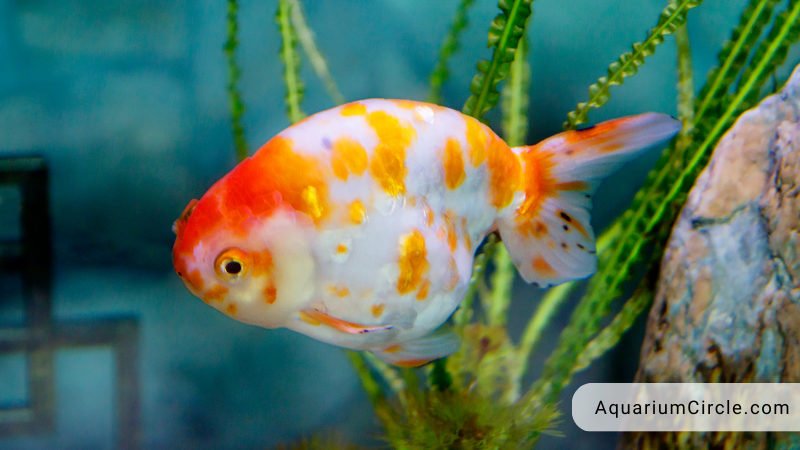
Determining the sex of Shubunkin Goldfish can be challenging, especially when they are young. However, there are a few physical characteristics that can help you identify the sex of your fish as they mature.
One of the most reliable ways to tell the difference between male and female Shubunkin Goldfish is to look at their vent area, which is located on the underside near their anus. In males, this area is typically more pronounced and appears rounder and more raised than in females. In females, the vent area is flatter and wider.
Another way to distinguish between male and female Shubunkin Goldfish is to look at their pectoral fins, which are located on the sides of their body near their head. In males, these fins may appear thicker and more pointed than in females, while females may have shorter and more rounded pectoral fins.
Finally, during breeding season, males may develop small white spots, known as breeding tubercles, on their gill plates and along their head and pectoral fins.
It’s important to note that these characteristics may not be noticeable until the fish reach maturity, which can take several months or even a year. Additionally, some individual fish may not exhibit clear male or female traits, making it more difficult to determine their sex.
Shubunkin Goldfish Care: What Is The Ideal Tank Size For Them?
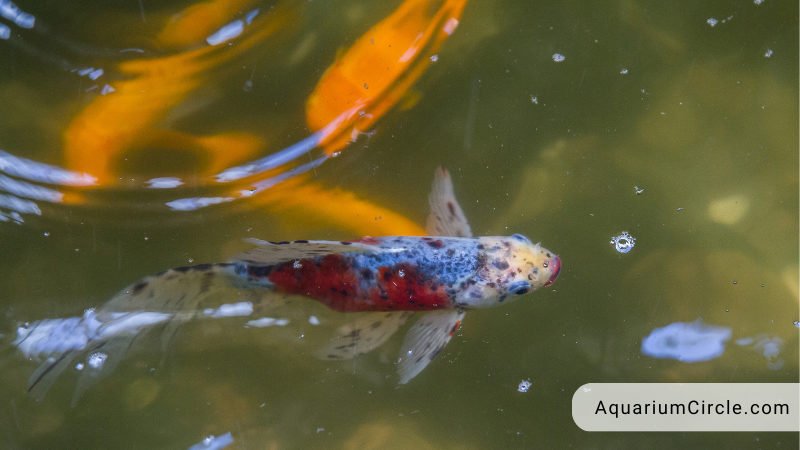
Shubunkin Goldfish are active swimmers and can grow to be quite large, reaching up to 12 inches (30 cm) in length. As such, they require a relatively large tank to ensure they have enough space to swim and thrive.
The minimum tank size for a single Shubunkin Goldfish is 30 gallons (113 liters). However, as they grow, they will require more space. For two Shubunkin Goldfish, a 55 gallon tank (208 liters) is recommended, and for a larger group, a 75-gallon tank (284 liters) or larger tank would be necessary.
It’s important to note that a larger tank not only provides more swimming space but also allows for better water quality and reduces the risk of disease and stress. Additionally, Shubunkin Goldfish are social fish and enjoy the company of their own kind, so keeping them in groups is recommended.
When setting up a proper tank for Shubunkin Goldfish, it’s also important to provide adequate filtration and maintain a regular cleaning schedule to ensure good water quality.
See also: 20 Gallon Fish Tank Goldfish: How Many Goldfish In A 20 Gallon Tank?
Ideal Water Condition – How To Maintain Good Water Quality For Your Fish?
Maintaining good water quality is essential for the health and well-being of Shubunkin Goldfish. These fish are sensitive to changes in water chemistry and require a stable environment to thrive.
The ideal water conditions for Shubunkin Goldfish include:
- Temperature: The water temperature should be kept between 65-75°F (18-24°C), with 68-72°F (20-22°C) being the ideal range.
- pH: The pH level should be between 7.0-8.0.
- Ammonia and Nitrite: These levels should always be kept at 0 ppm as they can be toxic to fish.
- Nitrate: The nitrate level should be kept below 40 ppm. Frequent partial water changes can help maintain healthy nitrate levels.
- Water hardness: Shubunkin Goldfish prefer slightly hard water with a hardness level of 100-150 ppm. If your water source is too soft, consider adding a water hardener.
- Chlorine and other harmful substances: Tap water often contains chlorine and other harmful substances that can be harmful to fish. Always treat tap water with a water conditioner to neutralize any harmful substances before adding it to the tank.
- Oxygenation: Shubunkin Goldfish require a well-oxygenated environment to breathe properly. Ensure there is adequate surface agitation, such as with a filter, air pump, or powerhead, to increase oxygen levels in the water.
- Avoid overcrowding: Overcrowding can lead to poor water quality and increased stress levels for your fish. As a general rule, aim for no more than one inch of fish per gallon of water.
- Monitor water parameters: Regularly test the water parameters using a reliable test kit to monitor levels of ammonia, nitrite, nitrate, and pH. Any significant fluctuations should be addressed immediately to prevent stress or illness in your fish.
- Maintenance: In addition to regular water changes, regular maintenance tasks such as cleaning the tank and filter, removing uneaten food and debris, and monitoring equipment such as heaters and filters are essential for maintaining good water quality.
By providing optimal water conditions and quality for your Shubunkin Goldfish, you can help ensure that they remain healthy and happy in their environment.
Suitable Tank Mates For Shubunkin Goldfish
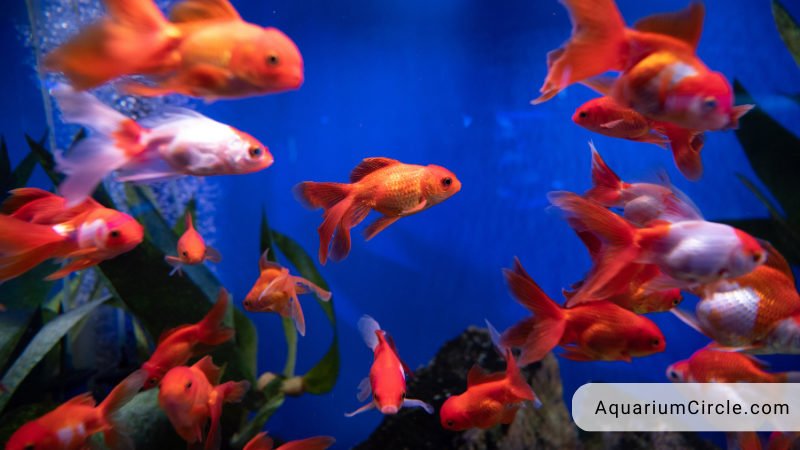
Like other goldfish, Shubunkin Goldfish are social fish and can be kept with other fish as long as they are compatible in terms of size, temperament, and water parameters. Here are some suitable tank mates for Shubunkin Goldfish:
- Other goldfish: Shubunkin Goldfish can be kept with other goldfish species such as Common Goldfish, Comet Goldfish, and Fantail Goldfish. As a general rule, avoid mixing goldfish with fancy goldfish such as Orandas, Ryukins, and Lionheads as they have different body shapes and may compete for food.
- Koi: Koi and Shubunkin Goldfish are both coldwater fish and can be kept together in a large pond or aquarium. However, keep in mind that Koi can grow much larger than Shubunkin Goldfish and may bully them for food.
- White Cloud Mountain Minnows: These small, peaceful fish are ideal tank mates for Shubunkin Goldfish as they have similar water requirements and are not aggressive.
- Zebra Danios: These active, schooling fish can also be kept with Shubunkin Goldfish as they are hardy and fast-swimming, making them less likely to be harassed by the larger fish.
- Rosy Barbs: These active, colorful fish are also compatible with Shubunkin Goldfish as long as they are kept in a large enough tank.
When introducing new fish to your Shubunkin Goldfish, it’s important to quarantine them for a few weeks to prevent the spread of diseases. Additionally, ensure that the tank is large enough to accommodate all the fish comfortably, and monitor their behavior closely to ensure that they are getting along.
See also: Can Betta Fish Live With Goldfish? – 3 Reasons Why They Are Not Along
Diet And Feeding Shubunkin Fish
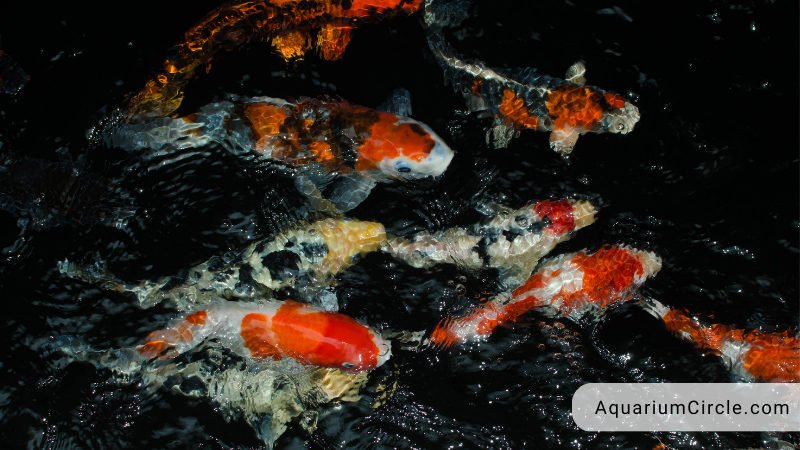
Shubunkin Goldfish are omnivorous and require a balanced diet that includes both plant-based and protein-based foods. Here are some typical foods that you can feed your Shubunkin Goldfish:
- Pellets: Commercial fish pellets specifically formulated for goldfish are an excellent staple food for Shubunkin Goldfish. Look for pellets that contain a variety of ingredients such as spirulina, krill, and shrimp to provide a balanced diet.
- Flakes: High-quality fish flakes are also suitable for Shubunkin Goldfish, but they can be less nutritious than pellets. Look for flakes that contain a high percentage of protein and vegetable matter.
- Vegetables: Shubunkin Goldfish enjoy a variety of fresh vegetables such as peas, lettuce, spinach, and zucchini. These can be blanched or boiled before feeding to make them easier to digest.
- Live foods: Shubunkin Goldfish also enjoy live foods such as brine shrimp, bloodworms, and daphnia. These should be fed sparingly as they can be high in protein and fat.
- Freeze-dried foods: Freeze-dried foods such as krill, shrimp, and tubifex worms are also suitable for Shubunkin Goldfish. However, these should be rehydrated before feeding to prevent digestive problems.
When feeding your Shubunkin Goldfish, it’s important to provide a varied diet to ensure that they receive all the nutrients they need. Feed small amounts several times a day rather than one large meal to prevent overeating and bloating. Additionally, avoid overfeeding as this can lead to health problems such as obesity and swim bladder disease.
See also: Are Goldfish Edible? – 3 Reasons They’re Never A Great Meal
Feeding schedule and frequency
The feeding schedule and frequency for Shubunkin Goldfish depends on the age, size, and activity level of the fish. Here are some general guidelines to follow:
- Young Shubunkin Goldfish: Feed young Shubunkin Goldfish two to three times a day with small portions of food. Pellets or flakes that are specifically formulated for goldfish are a good option.
- Adult Shubunkin Goldfish: Adult Shubunkin Goldfish can be fed once or twice a day with larger portions of food. It’s important to monitor their weight and adjust their feeding accordingly to prevent obesity.
- Vegetables: Fresh vegetables such as peas, lettuce, and spinach should be offered once or twice a week. These should be boiled or blanched before feeding to make them easier to digest.
- Live or freeze-dried foods: Live or freeze-dried foods such as brine shrimp, bloodworms, and krill can be offered once a week or as a treat. These should be fed sparingly as they are high in protein and fat.
- Fasting: Shubunkin Goldfish can fast for a day or two each week to help prevent digestive problems and keep their digestive system healthy.
It’s important not to overfeed Shubunkin Goldfish as they have a tendency to overeat and can suffer from health problems as a result. Feed them only what they can consume within a few minutes and remove any uneaten food to prevent it from fouling the water. Additionally, vary their diet to ensure that they receive all the nutrients they need to stay healthy.
Shubunkin Goldfish Breeding
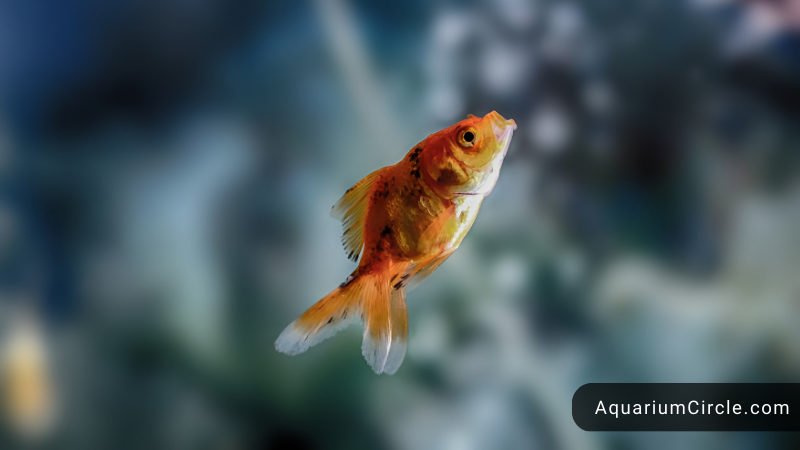
Breeding shubunkin fish is a fascinating process that requires patience and attention to detail. Here are the general steps involved in shubunkin breeding:
- Selecting the right fish: The first step in shubunkin breeding is to select healthy and high-quality fish. Look for fish that have bright and vibrant colors, good body shape, and are free from any signs of disease or deformities. It’s also important to select a male and female fish that are sexually mature.
- Preparing the breeding tank: Shubunkin fish require a large breeding tank that is at least 40 gallons in size. Fill the tank with clean and conditioned water and provide plenty of hiding places, such as plants and rocks, for the fish to spawn in.
- Conditioning the fish: Before breeding, it’s important to condition the male and female fish by feeding them a high-protein diet and gradually increasing the temperature of the water to simulate the breeding season.
- Introducing the fish: Once the fish are conditioned, introduce the male and female into the breeding tank. Keep a close eye on them and watch for signs of courtship behavior, such as chasing and nudging.
- Spawning: During spawning, the male fish will chase the female and nudge her to release her eggs. The male will then release his sperm to fertilize the eggs. The eggs will stick to the plants or rocks in the tank, and the parents should be removed from the tank to prevent them from eating the eggs.
- Hatching and raising the fry: The shubunkin eggs will hatch in about 5-7 days, and the fry will start to swim freely a few days later. Feed the fry small amounts of freshly hatched brine shrimp or specialized fry food several times a day. Keep the water clean and well-oxygenated, and remove any dead or sick fry to prevent disease from spreading.
- Growing out the fry: As the fry grow, you can start to introduce more solid food, such as crushed flakes or small pellets. Gradually increase the size of the food as the fry grow, and continue to monitor the water quality and temperature to ensure healthy growth.
Breeding shubunkin fish can be a rewarding experience, but it requires careful attention to detail and a willingness to invest time and resources into the process.
Common Health Issues And Diseases That Affect Shubunkin Goldfish
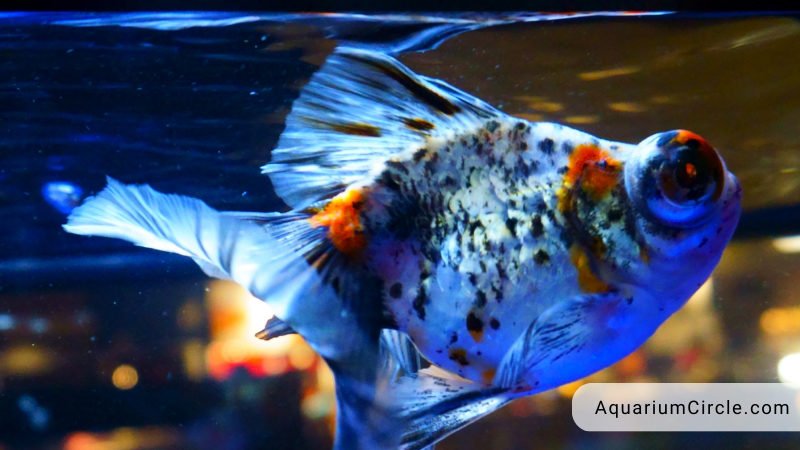
Shubunkin goldfish are hardy creatures, like all fish, but they are still prone to certain health issues and diseases. Here are some common health problems that shubunkin goldfish may experience:
- Swim bladder disorder: This condition affects the fish’s ability to control its buoyancy and may cause it to float or sink. It may be caused by overfeeding or constipation.
- Ich: This is a common parasitic infection that causes white spots to appear on the fish’s body, fins, and gills. It is highly contagious and can be fatal if left untreated.
- Fin rot: This bacterial infection can cause the fish’s fins to become ragged and frayed. It may be caused by poor water quality or physical injuries.
- Dropsy: This condition causes the fish’s abdomen to become swollen and bloated, and may be a sign of kidney or liver failure.
- Mouth rot: This bacterial infection affects the fish’s mouth and may cause inflammation, ulcers, or decay of the tissue.
- Fungal infections: These infections can cause white or gray patches to appear on the fish’s body, fins, or eyes.
- Velvet disease: This is a parasitic infection that causes the fish’s skin to appear dusty or velvety. It may also cause the fish to become lethargic and lose its appetite.
- Columnaris: This bacterial infection can cause the fish’s skin to become covered in a slimy film, and may also cause ulcers, fin rot, or respiratory problems.
- Lice and flukes: These are external parasites that can cause the fish’s skin to become irritated or inflamed. They may also cause the fish to scratch against objects in the tank.
- Anchor worm: This is a parasitic infection that causes long, white or pinkish threads to protrude from the fish’s body. It may also cause red, swollen areas where the worm has attached.
Prevention is the best approach to avoid these health problems. Maintaining a clean and well-filtered tank, providing a balanced and nutritious diet, and avoiding overcrowding can help prevent disease. If you suspect that your shubunkin goldfish is experiencing any of these health issues or other symptoms, it’s important to consult with a veterinarian or aquatic specialist for proper diagnosis and treatment.
See also: Why Is My Goldfish Turning Black: 10 Common Reasons & What You Should Do
Video About Shubunkin Goldfish
FAQs
What size do Shubunkin Goldfish grow to?
Shubunkin Goldfish can grow up to 8-12 inches in length.
How long do Shubunkin Goldfish live?
Shubunkin Goldfish can live up to 15 years or more with proper care and a suitable environment.
Can Shubunkin Goldfish live with other fish?
Yes, Shubunkin Goldfish can live with other peaceful fish species that require similar water conditions. However, they should not be kept with aggressive or predatory fish.
References

Annette M. Chaney is an experienced marine biologist with over 20 years of experience as an aquarist and fishkeeper. She started her first aquarium at a young age, filling it with frogs and goldfish obtained from the ten-cent pet store.
Annette grew up caring for and breeding African Cichlids, which led to a hobby in high school that doubled as a profitable means. Attending Reed College gave her time to solidify herself as an accomplished aquarium caretaker with an eye for sales. After that, from 2009 – 2013, she studied at Roger Williams University – one of the most prestigious universities for Aquaculture and Aquarium in USA. She is the founder of AquariumCircle since 2010.
